
Key Benefits
- Clarify whether you have enough riboflavin to power energy production.
- Spot early shortfalls behind mouth cracks, sore tongue, skin or eye irritation.
- Explain fatigue or anemia by checking a vitamin needed for red cells.
- Guide targeted diet or supplements to correct deficiency and restore energy.
- Clarify high homocysteine, especially with MTHFR variants, and guide B-vitamin support.
- Protect pregnancy by confirming adequacy during higher needs or persistent vomiting.
- Track recovery after bariatric surgery, malabsorption, alcoholism, or restrictive diets.
- Best interpreted with folate, B12, homocysteine, CBC, ferritin, and symptoms.
What is Vitamin B2 (Riboflavin)?
Vitamin B2, or riboflavin, is a water-soluble B vitamin that the body cannot make and must obtain from food. It is found in dairy, eggs, meats, and green vegetables, and is often added to grains. After absorption, riboflavin is rapidly converted inside cells into its working forms, flavin mononucleotide (FMN) and flavin adenine dinucleotide (FAD). These flavin coenzymes carry riboflavin’s activity throughout the body.
Riboflavin’s core job is to enable oxidation–reduction reactions—the electron transfers that drive cellular energy production. As FMN and FAD, it partners with enzymes that metabolize carbohydrates, fats, and proteins and feed electrons into the respiratory chain. It also supports antioxidant defenses by regenerating glutathione (via glutathione reductase) and helps activate other vitamins, including vitamin B6 (pyridoxal 5′-phosphate) and the folate cycle (FAD-dependent MTHFR). As a biomarker, riboflavin reflects the body’s supply of these flavin coenzymes and, by extension, its capacity to produce energy efficiently and maintain redox balance.
Why is Vitamin B2 (Riboflavin) important?
Vitamin B2 (riboflavin) is the entry ticket to FMN and FAD, the coenzymes that power hundreds of flavoproteins. These enzymes run mitochondrial energy production (Complex I and II), burn fats and carbs, recycle antioxidants (glutathione reductase), support iron handling and hemoglobin, and help “activate” other vitamins (B6, niacin, folate) that shape neurotransmitters and vascular tone.
Labs assess status by blood or urine riboflavin, or by an enzyme-based functional test. Reference ranges vary, but true physiological sufficiency sits in the middle, where flavoprotein enzymes are saturated and stable. Very low values reflect deficiency; very high blood or urine values often mirror recent intake rather than tissue status.
When values are low, cells can’t transfer electrons efficiently. The result is tiredness, reduced exercise tolerance, cracked corners of the mouth, sore tongue, scaly facial rash, light sensitivity or red eyes, and anemia from impaired iron utilization. Children may show slowed growth; teens feel disproportionate fatigue with training. In women, oral contraceptives and pregnancy increase risk of low status; pregnancy deficiency can worsen anemia and is linked to higher blood pressure risk in susceptible genotypes via impaired MTHFR function.
When values are high, riboflavin’s water solubility means excess is usually excreted, often turning urine bright yellow. Persistently high readings typically indicate recent ingestion, not toxicity or organ damage.
Big picture: riboflavin sits at the crossroads of mitochondria, redox balance, iron metabolism, and one‑carbon/folate pathways. Adequate status supports cognition, skin and eye integrity, cardiovascular and pregnancy health, and long-term metabolic resilience.
What Insights Will I Get?
Vitamin B2 (riboflavin) reflects the body’s supply of FMN and FAD, coenzymes that drive hundreds of redox reactions. These support mitochondrial energy production, fatty‑acid oxidation, and the activation of other vitamins. Riboflavin also powers glutathione recycling for antioxidant defense, helps mobilize iron for red blood cell production, and supports one‑carbon metabolism that influences homocysteine, cardiovascular risk, cognition, and reproduction.
Low values usually reflect insufficient intake, malabsorption, or higher needs from growth, pregnancy, or chronic illness. Functionally, limited FMN/FAD slows ATP generation and fat oxidation, increases oxidative stress, and impairs activation of vitamin B6 and folate enzymes (including MTHFR), which can raise homocysteine. System effects often include fatigue, sore mouth or lips, skin and eye irritation, and can contribute to anemia. Older adults and people with gastrointestinal disorders are more susceptible; pregnancy increases requirements and maternal deficiency may affect fetal development.
Being in range suggests adequate coenzyme availability for stable energy metabolism, balanced redox status, effective homocysteine handling, and healthy iron utilization and mucosal integrity. Most laboratories consider mid‑range values consistent with sufficiency when paired with normal functional markers.
High values usually reflect recent fortified intake or supplementation, parenteral nutrition, or reduced renal clearance; excess riboflavin is water‑soluble and typically excreted, so toxicity is rare. Persistently high levels without recent intake can suggest impaired kidney excretion or timing effects.
Notes: Interpretation depends on the assay. Plasma or erythrocyte riboflavin/FMN/FAD rise with intake, whereas a higher erythrocyte glutathione reductase activation coefficient indicates poorer status. Pregnancy, inflammation, aging, and renal function can shift circulating levels independent of tissue stores, and riboflavin is light‑sensitive, so sample handling matters.






.avif)



.svg)





.svg)


.svg)


.svg)

.avif)
.svg)










.avif)
.avif)
.avif)


.avif)
.png)


